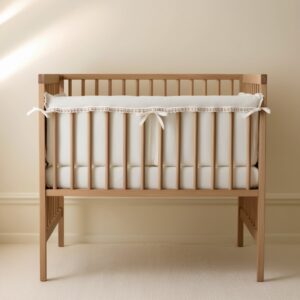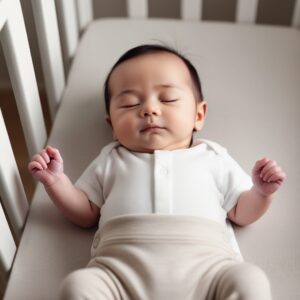It is among the major ways that a baby can be kept healthy and comfortable. A good sleeping environment minimizes risks associated with SIDS while helping a baby sleep better and, hence, the parents sleeping better too. This guide will go through the necessary elements and tips to create a safe, soothing, and effective sleep environment for your child.
1. Choosing the Right Crib and Mattress
The crib and mattress are both important foundational elements in creating a safe sleep space. Look for a crib that meets safety regulations to help you avoid any possible dangers.
- Crib Standards: The crib needs to meet the standards of safety. It cannot have any free parts, sharp edges, or drop-down sides.
- Mattress Fit: A firm mattress fitting snugly inside the crib without any gaps is recommended. Gaps are an entrapment hazard. A well-fitting mattress should allow no more than two fingers between the mattress and crib side.
- Sleep Surface: The infant should be constantly placed on a firm mattress with nothing soft beneath or next to him, like pillows, blankets, or plush toys.

2. Optimal Room Temperature and Air Quality
A comfortable and healthy nursery environment supports safe sleep.
- Room Temperature: Experts recommend keeping the room temperature between 68°F and 72°F (20-22°C). Overheating of babies is related to an increased danger of SIDS; hence, the room should be comfortably cool.
- Air Quality: An air purifier helps filter out allergens, dust, and other particles that may disturb your baby’s breathing. Keep him away from smoke, strong fragrance, or pollutants.
- Ventilation: Ensure the room is well-ventilated to enable circulation of fresh air. In some cases, a ceiling fan can reduce the risk of SIDS by increasing the flow of air.

3. Sleep Position and Safety Practices
Observing safety while the baby is sleeping reduces risks linked to unsafe sleeping habits.
- Back Sleeping: The American Academy of Pediatrics encourages that the baby should always be positioned on their back while putting them to sleep; this sleeping position greatly reduces the risks of SIDS.
- Avoid Inclined Surfaces: Do not use inclined sleepers, car seats, or any other surface that is not designed for sleeping. A level, sturdy surface is ideal for infants to sleep on.
- Swaddling: If swaddling, stop once the baby shows signs of rolling over. Alternatively, a sleep sack could be a safer alternative for keeping babies warm rather than having free blankets in the bed.

4. Limiting Accessories in the Crib
Though they might look cute, accessories can be quite serious risks to your baby. Anything in the crib should not create a risk to your baby’s breathing.
- No Loose Bedding: One doesn’t need blankets, pillows, or crib bumpers. They are very risky to the baby. If the baby needs to wear something, use a wearable blanket.
- No Toys: Stuffed toys or hanging objects like mobiles can easily cause strangulation or suffocation. The area of sleep should contain just what is necessary.
5. Nighttime Lighting and Noise Control
Comfortable sleep conditions can result in a baby sleeping for longer hours without disruption.
- Lighting: A dim night light can be used when necessary, but avoid bright or flashing lights that interrupt the baby’s sleep. A very dim light can facilitate nighttime feeding or changing without fully waking up the baby.
- White Noise Machine: For babies, an unbroken sound could work great. It masks the household sounds and helps to send the baby off to sleep; it is like a womb effect.
6. Standard Bedtime Routine
Making a predictable pattern helps babies feel more secure and ready for bed.
- Same Routine, Same Time: A light bedtime routine-a bath, massage, and lullaby-tell the baby that this is sleep time.
- No Screens: Not even a single screen should be there in the nursery; the blue light it emits disrupts sleep. Instead, use soothing activities such as telling stories or soft music.
7. Use a Baby Monitor to Monitor the Environment
A baby monitor can be one of those things that genuinely provide peace of mind when your baby is sleeping. Just make sure to select a model with safety features and not one that will merely become a distraction.
- Video and Audio: The monitor will enable the caretaker to visually and auditorily check on the baby without having to enter the room, which might wake them up.
- Breath-Tracking Monitors: Advanced monitors track breathing patterns, providing parents with further reassurance through notifications when irregularities are detected.
8. Baby’s Clothing and Sleepwear
Your baby’s clothing can also be one of the factors affecting their comfort and safety when sleeping.
- Breathable Fabrics: Wearing sleepwear made of cotton or bamboo allows breathability and maintains the tendency not to overheat.
- Avoid Overdressing: Generally speaking, a baby needs one layer more than what you wear on. Sleep sacks are highly recommended to keep them warm enough with no risks involved, as with blankets.



